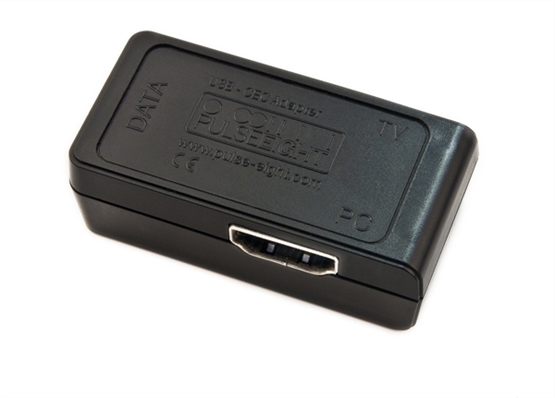External CEC adapter
USB - CEC Adapter from Pulse-Eight

Get the hardware
Get the software
Connect “TV” port on the adapter to your TV
Connect USB mini port to you computer
Install the cec-client
- Linux
sudo apt-get install cec-utils
- mac (using MacPorts)
sudo /opt/local/bin/port install libcec
run the client
$ cec-client No device type given. Using 'recording device' CEC Parser created - libCEC version 4.0.2 no serial port given. trying autodetect: path: /dev/cu.usbmodemv1 com port: /dev/cu.usbmodemv1 opening a connection to the CEC adapter... DEBUG: [ 1] Broadcast (F): osd name set to 'Broadcast' DEBUG: [ 3] connection opened, clearing any previous input and waiting for active transmissions to end before starting DEBUG: [ 10] communication thread started DEBUG: [ 70] turning controlled mode on NOTICE: [ 255] connection opened DEBUG: [ 255] processor thread started DEBUG: [ 255] << Broadcast (F) -> TV (0): POLL TRAFFIC: [ 255] << f0 DEBUG: [ 255] setting the line timeout to 3 DEBUG: [ 403] >> POLL sent DEBUG: [ 403] TV (0): device status changed into 'present'
Add timestamps
Use the ts command to add timestamps.
$ cec-client | ts Nov 18 16:15:46 No device type given. Using 'recording device' Nov 18 16:15:46 CEC Parser created - libCEC version 4.0.4 Nov 18 16:15:46 no serial port given. trying autodetect: Nov 18 16:15:46 path: /sys/devices/pci0000:00/0000:00:14.0/usb2/2-9 Nov 18 16:15:46 com port: /dev/ttyACM0 Nov 18 16:15:46 Nov 18 16:15:46 opening a connection to the CEC adapter... Nov 18 16:15:46 DEBUG: [ 386] Broadcast (F): osd name set to 'Broadcast'
ts is part of the moreutils package
sudo apt-get install moreutils
cheat sheets
Show all connected devices
$ echo scan | cec-client -s -d 1
Available Commands
[tx] {bytes} : transfer bytes over the CEC line.
[txn] {bytes} : transfer bytes but don't wait for transmission ACK.
[on] {address} : power on the device with the given logical address.
[standby] {address} : put the device with the given address in standby mode.
[la] {logical address} : change the logical address of the CEC adapter.
[p] {device} {port} : change the HDMI port number of the CEC adapter.
[pa] {physical address} : change the physical address of the CEC adapter.
[as] : make the CEC adapter the active source.
[is] : mark the CEC adapter as inactive source.
[osd] {addr} {string} : set OSD message on the specified device.
[ver] {addr} : get the CEC version of the specified device.
[ven] {addr} : get the vendor ID of the specified device.
[lang] {addr} : get the menu language of the specified device.
[pow] {addr} : get the power status of the specified device.
[name] {addr} : get the OSD name of the specified device.
[poll] {addr} : poll the specified device.
[lad] : lists active devices on the bus
[ad] {addr} : checks whether the specified device is active.
[at] {type} : checks whether the specified device type is active.
[sp] {addr} : makes the specified physical address active.
[spl] {addr} : makes the specified logical address active.
[volup] : send a volume up command to the amp if present
[voldown] : send a volume down command to the amp if present
[mute] : send a mute/unmute command to the amp if present
[self] : show the list of addresses controlled by libCEC
[scan] : scan the CEC bus and display device info
Sending Remote Control Events
You can send CEC remote events using the tx command above. The format is as follows:
tx <source id><destination id>:<command id>:<param value>
where all of the above parameters should be filled in with a single HEX digit (except <command id>, which requires 2 digits). Here, we want to send commands to the Android TV, so we will place its ID in <destination id>. The scan command above will give you the IDs for each device that the CEC adapter is aware of.
In the examples below the DUT is a CEC player device with a logical address of 4. Here are some useful commands to execute remote actions:
Press home
tx 04:44:09
Press select
tx 04:44:00
Press d-pad up
tx 04:44:01
Press d-pad down
tx 04:44:02
Press d-pad left
tx 04:44:03
Press d-pad right
tx 04:44:04
You can check out https://www.cec-o-matic.com/ for more info on formatting your request and a full list of commands and their respective parameters.